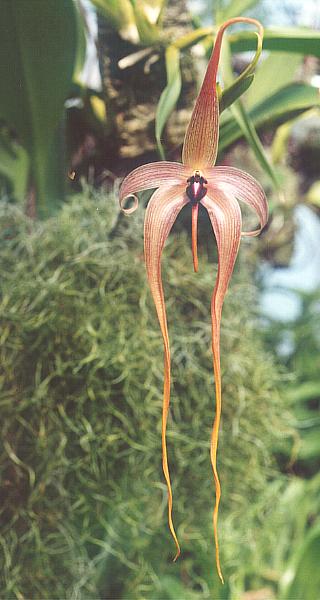
Bulbophyllum is a genus of mostly epiphytic and lithophytic orchids in the family Orchidaceae. It is the largest genus in the orchid family and one of the largest genera of flowering plants with more than 2,000 species, exceeded in number only by Astragalus. These orchids are found in diverse habitats throughout most of the warmer parts of the world including Africa, southern Asia, Latin America, the West Indies, and various islands in the Indian and Pacific Oceans. Orchids in this genus have thread-like or fibrous roots that creep over the surface of trees or rocks or hang from branches. The stem is divided into a rhizome and a pseudobulb, a feature that distinguished this genus from Dendrobium. There is usually only a single leaf at the top of the pseudobulb and from one to many flowers are arranged along an unbranched flowering stem that arises from the base of the pseudobulb. Several attempts have been made to separate Bulbophyllum into smaller genera, but most have not been accepted by the World Checklist of Selected Plant Families.

Kirstenbosch is an important botanical garden nestled at the eastern foot of Table Mountain in Cape Town. The garden is one of 10 National Botanical Gardens covering five of South Africa's six different biomes and administered by the South African National Biodiversity Institute (SANBI). Prior to 1 September 2004, the institute was known as the National Botanical Institute.
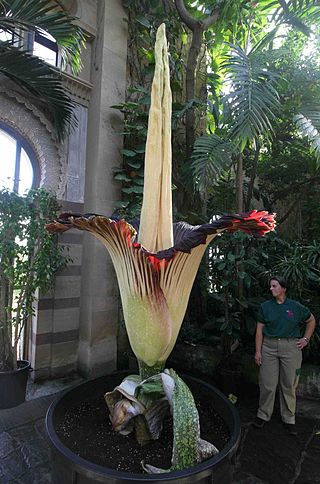
Carrion flowers, also known as corpse flowers or stinking flowers, are mimetic flowers that emit an odor that smells like rotting flesh. Apart from the scent, carrion flowers often display additional characteristics that contribute to the mimesis of a decaying corpse. These include their specific coloration, the presence of setae and orifice-like flower architecture. Carrion flowers attract mostly scavenging flies and beetles as pollinators. Some species may trap the insects temporarily to ensure the gathering and transfer of pollen.

Satyrium is a genus of orchid. The Kew plant list for 2010 listed 85 full species as accepted, ignoring synonyms, subspecies and hybrids etc. About ten were still unresolved at the time. Most of the species occur in sub-Saharan Africa and Madagascar. The ranges of four species extend to Asia, mainly in India and Sri Lanka. Hybridization occurs between several species, complicating molecular phylogenetic studies, especially those relying on mitochondrial and chloroplast DNA sequences.

Disa bracteata, also known as the bract disa, leek orchid or the South African weed orchid is a species of orchid native to South Africa.

Satyrium carneum is a species of orchid endemic to southwestern Western Cape. It is also known by the names pink satyr orchid, rooikappie, or rooitrewwa.

Satyrium coriifolium is a species of orchid endemic to the Cape Provinces. It is commonly known as the orange satyre or Ewwa-trewwa in Afrikaans.
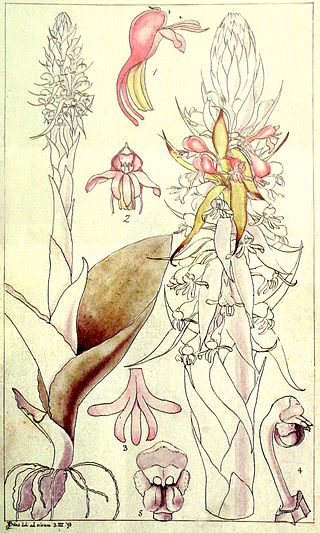
Satyrium macrophyllum is a species of orchid occurring from Kenya to South Africa.

Satyrium odorum is a species of orchid endemic to southwestern Cape Province.
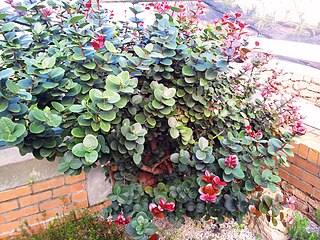
Maurocenia frangula is a small, rounded tree of about 4 metres, that is endemic to the Western Cape, South Africa.

Basiothia schenki, the brown striped hawk, is a moth of the family Sphingidae. The species was first described by Heinrich Benno Möschler in 1872. It is known from Zimbabwe and South Africa.

Asparagus densiflorus (among several species colloquially called asparagus ferns; no relation to actual ferns), or the foxtail fern (asparagus) or plume fern, is a variable, evergreen-perennial plant related to cultivated, edible asparagus.

In evolutionary biology, mimicry in plants is where a plant evolves to resemble another organism physically or chemically, increasing the mimic's Darwinian fitness. Mimicry in plants has been studied far less than mimicry in animals, with fewer documented cases and peer-reviewed studies. However, it may provide protection against herbivory, or may deceptively encourage mutualists, like pollinators, to provide a service without offering a reward in return.

Geissorhiza radians or winecup flower is a highly threatened species from the Iris family with fewer than 10 remaining sub-populations growing in south-western Cape Town, South Africa. The deep purple flowers with large, red centres grow is dense colonies which makes for a spectacular flower displays from mid-September, particularly around the town of Darling. Its seasonally wet lowlands habitat is however becoming increasingly threatened with more than 80% of its original habitat now permanently transformed into agriculture or urban sprawl and the remaining populations threatened by encroaching invasive alien vegetation and fertilizer runoff. The dark-centred flowers aim to attract specific pollinators from the horsefly family (Tabanidae), but the specific interactions still require additional investigation. Each plant has 1 to 6 flowers. It is also found in smaller patches through to Gordon's Bay. The plants nearly always occur in seasonally moist wetlands which become dry in the summer months.
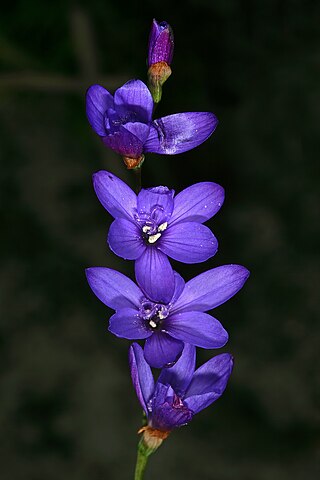
Geissorhiza aspera, also known as the blue satin flower or blou sysie, is a geophyte from South Africa.

Orbea variegata is a species of flowering plant in the family Apocynaceae, known as the star flower. It is native to the coastal belt of the Western Cape, South Africa, growing actively during the winter rainfall season. It is an invasive species in southern Australia.

Bartholina burmanniana, the spider orchid, is a species of deciduous, geophytic, flowering plant in the family Orchidaceae. It is one of two species within the Bartholina genus, the other being B. etheliae. The species’ common name refers to its spreading and deeply cut lip that is said to resemble a spider's legs. It is native to the Eastern and the Western Cape Provinces of South Africa, flowering from the end of August to the middle of October and peaking in September. This is one of the species sometimes referred to as "spider orchid".

The pollination of orchids is a complex chapter in the biology of this family of plants that are distinguished by the complexity of their flowers and by intricate ecological interactions with their pollinator agents. It has captured the attention of numerous scientists over time, including Charles Darwin, father of the theory of evolution by natural selection. Darwin published in 1862 the first observations of the fundamental role of insects in orchid pollination, in his book The Fertilization of Orchids. Darwin stated that the varied stratagems orchids use to attract their pollinators transcend the imagination of any human being.
Lycium pumilum is a shrub in the nightshade family (Solanaceae) indigenous to South Africa and Namibia.
Lycium cinereum is a shrub in the nightshade family (Solanaceae) indigenous to southern Africa. It is widespread across South Africa, as well as southern Namibia and Botswana.



















